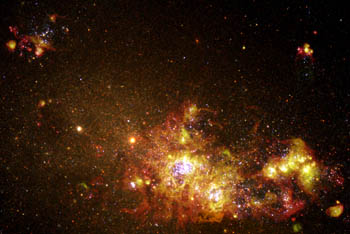
There is much to see in the night's sky. With the unaided eye, there are the constellations, shooting stars (or meteors), several of the planets (Mercury, Venus, Mars, Jupiter and Saturn are all visible to the unaided eye), and of course our moon.
Also visible are some of the man-made interlopers in the night sky.
Communication and weather satellites can often be seen (especially in the Summer) and you might see the International Space Station.
Many people have access to a pair of binoculars, but never think to turn them on the night sky. A decent pair of binoculars is a great way of getting in to astronomy. Binoculars gather in more light than the human eye so not only do they bring things closer, you can actually see a lot of stars that are invisible to the unaided eye.
Take a trip along the milky way with binoculars and you will see just how many stars surround us. Turn the binoculars on the moon and you can see many craters jump into focus. In the winter you can see the Orion Nebula (a stellar nursery) and star clusters such as the Pleiades and the Beehive cluster.
In the summer months you can see the Great Cluster in Hercules. This is a tightly knit group of about one million stars that appear like a faint ball of light. Also visible with binoculars is the Great Galaxy in Andromeda. A huge galaxy about 2.5 million light years from earth.
Since the earliest civilisations, mankind has studied the stars. Heroes and gods have been placed among them. Great stories have been woven in the constellations. Perseus, Andromeda, Hercules and Pegasus all look down on us from the sky. So many people throughout history have been enthralled by the stars, why not join them?

